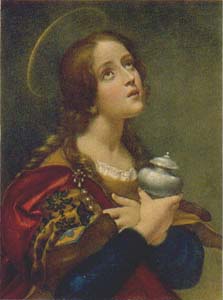
At the end of Matthew, the author makes note that Mary and Mary Magdalene went down to see the tomb and were informed that Jesus was no longer there, for he had risen. In Matthew 28:9-10, it states that Jesus greeted BOTH Mary and Mary Magdalene, so why then, in the Gospel of Mark, does it state that: "Now when he rose early on the first day of the week, he appeared first to Mary Magdalene, from whom he had cast out seven demons." (Mark 16:9). Why in Mark's story is it just Mary Magdalene and why is she the first person he appears to? Did Mark just CHOOSE to omit Mary or did Matthew get it wrong?
 In researching this question, I found a few differing opinions. It seems that in the books of Mark and John, Jesus appears only to Mary Magdalene (or, as in John, it is not explicitly stated that Jesus only appears to Mary Magdalene, it states, "Mary Magdalene went and announced to the disciples, "I have seen the Lord"---and that he had said these things to her" John 20:18.) Therefore, it seems that only the Gospel of Mark states that "Jesus appeared first to Mary Magdalene".
In researching this question, I found a few differing opinions. It seems that in the books of Mark and John, Jesus appears only to Mary Magdalene (or, as in John, it is not explicitly stated that Jesus only appears to Mary Magdalene, it states, "Mary Magdalene went and announced to the disciples, "I have seen the Lord"---and that he had said these things to her" John 20:18.) Therefore, it seems that only the Gospel of Mark states that "Jesus appeared first to Mary Magdalene".According to TaborBlog , the Gospel of Mark mentions Mary Magdalene only 3 times, at the crucifixion, the burial, and after the resurrection. Why in Mark's gospel did Mary Magdalene see Jesus FIRST? Why would Jesus appear before her first, when according to some, she was an extreme sinner and a "harlot"? (http://justus.anglican.org/resources/bio/206.html)
While googling and looking and trying to find SOMETHING, ANYTHING to answer this question, all I can find is that the gospel of Mark, "got it right", Mary Magdalene was the first person that Jesus appeared to, and that there is no contradiction in the other books regarding the resurrection, because the others(Mary, the disciples, Cephas and the twelve, etc), saw Jesus AFTER Mary Magdalene did. (http://carm.org/bible-difficulties/matthew-mark/who-saw-jesus-first). It seems that some believe that Jesus appeared to Mary Magdalene first and that she was the first person to deliver the good news of Jesus' resurrection because she was his most loyal servant. According to many sources, Mary Magdalene stayed there with Jesus until the end, witnessing the crucifixion, seeing where his body was laid, and helped prepare for the embalming. Therefore, one can make the assumption that Mary Magdalene was the first to see Jesus after the resurrection, and the person to deliver the good news of Easter, because she never left his side. (The Expository Files).
In closing, I feel fairly certain that after the resurrection, Jesus appeared to Mary Magdalene first, because she was extremely loyal and she was the only one still hanging around mourning him and waiting. Most research points to this same answer, although with enough digging you can find the random conspiracy theory, or critic/blogger saying that Mark just omitted some things. I will add that, while talking to my husband about my blog question, he said that he believes that Jesus appeared to her first because they were in fact married, but he's a conspiracy theorist(he even thinks Tupac is alive for goodness sakes), so, we will just go ahead and ignore what he thinks, since that would be another blog for another day:)



